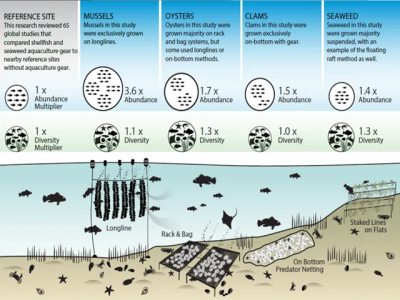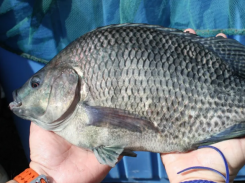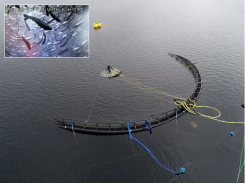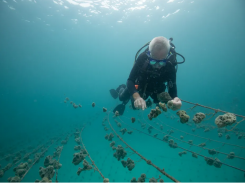Restorative aquaculture shows we can have more habitat, and eat it too

The aquaculture of edible bivalves and seaweeds can have a positive impact on marine habitat for fish and invertebrates, including crabs and lobsters, according to a new study.
The habitat benefits of seaweed and shellfish. Photo: TNC
For the first time, The Nature Conservancy (TNC), in collaboration with scientists from the University of New England, the University of Melbourne and the University of Adelaide, conducted a comprehensive global review of literature and analysis of 65 studies to quantify the relative habitat benefits of mussel, oyster, clam and seaweed farms. The results of this work show that farming systems for these species resulted in increased fish and invertebrate abundance and diversity in comparison to similar sites without farms present.
However, different aquaculture species and farming methods have different outcomes for nature. Aquaculture of bivalves – two-shelled animals like mussels, oysters, and clams – seems to provide habitat more effectively than aquaculture of seaweeds, though there is less research available reflecting the impact and benefits of the highly diverse seaweed farming methods and species.
Learning from past studies
The study shows that mussel farms tend to attract the greatest abundance of organisms – averaging about 3.6 times more fish and invertebrates compared to nearby reference sites. Oyster farms, on the other hand, attract the greatest species diversity, with 1.3 times greater diversity compared to reference sites.
Beyond providing habitat itself, seaweed and shellfish farms are also likely to increase habitat value, or the ability of wild organisms to survive and reproduce. Smaller organisms may be utilising the farm structure as refuge from predators, as well as eating the farmed product and other organisms that live on the farm. Larger predators may also be attracted to the farms for the farmed product, or as a hunting ground for the smaller fish or invertebrates that live around farms. And any organisms that survive and reproduce provide food for predators via their offspring.
Many bivalves are broadcast spawners that send their offspring into the water column the survivors float or swim off to settle elsewhere, establishing or supporting wild populations. Farm structures can also help produce habitat benefits by reducing environmental stresses. Farms can help dispel wave energy and reduce other types of physical challenges.
Aquaculture as habitat
Similar to many environmental sustainability considerations affecting other industries, the secret to habitat-provisioning success for seaweed and shellfish aquaculture is careful farm planning and diligence throughout the production cycle. Farms that are too crowded, are not rinsed well by currents, are built over existing habitats like reefs or seagrasses, or produce plastic pollution may actually have damaging effects on the ecosystem.
Research suggests that in large quantities or high densities, animals that filter the water in order to eat – for example, bivalves – can consume so much of the food, oxygen and nutrients in the water that other organisms can become stressed and struggle to survive. And, just like all animals, bivalves have to release their digested food somewhere. In fact, organisms like oysters produce both digested and undigested waste (called pseudofeces), which sink to the bottom.
While bivalves actively removing sediments and some nutrients from the water column can do wonders for water clarity, an over-accumulation of waste underneath farm sites can blanket benthic organisms. This can lead to an imbalance of benthic processes, and can even smother organisms to death. Such challenges can be addressed through the considering the location of farms and farming at appropriate densities.
Overall, the drivers of habitat value depend on the interaction of local environmental conditions, intensity and scale, gear utilised, species cultivated, and farm management practices. To avoid negative impacts from overcrowding or oversized farms, data-driven, science-informed aquaculture siting and analysis of the above factors is necessary.

How seaweed and shellfish provide habitat benefits. Photo: TNC
Developing aquaculture for habitat outcomes
The paper demonstrates a vast potential for food production in harmony with ocean ecosystems.
“We want to better understand how food production can go beyond the reduction of impact and actually provide benefits to the ocean,” says Robert Jones, one of the paper’s authors.
“We can work towards the UN sustainable development goals of zero hunger and protect – or better yet – restore damage to our oceans at the same time. This research is a significant step forward in demonstrating – through scientifically backed numbers – that this is possible.”
These findings are critical to rethinking how food production systems can provide for human needs, while also providing “restorative” benefits to our ecosystems at large. Fish consumption and the aquaculture industry are the fastest growing protein choice for diet and food production in the world right now, so there is an urgent need to scale solutions that can provide seafood without damaging ecosystems.
The authors of this study point out that while strong planning on a farm scale is critical to responsibly creating habitat through aquaculture, collaborative policy can drive change at larger scales. Conservation efforts, such as marine protected areas, historically have restricted opportunities for shellfish and seaweed aquaculture due to its industry status, when well managed farms may in fact help achieve the intended conservation goals of these efforts. Innovative collaborations between state or local governance and the people affected by such policies can lead to new ways of thinking about, and managing, both the social and environmental aspects of seaweed and shellfish aquaculture.
With a growing body of research quantifying the effects of seaweed and shellfish aquaculture, realising local, regional and global benefits of such practices become more tangible. Understanding the habitat benefits and better management practices necessary to deliver those benefits for bivalve and seaweed aquaculture is a strong step in the direction towards providing sustainable food for people and critical benefits to the environment.
Moving forward, scientists and planners can work to answer where and how shellfish and seaweed provide habitat, how to most effectively and responsibly encourage restorative practices in those areas, and how that shift can benefit marine ecosystems and communities at large.
Related news
Tools

Phối trộn thức ăn chăn nuôi

Pha dung dịch thủy canh

Định mức cho tôm ăn

Phối trộn phân bón NPK

Xác định tỷ lệ tôm sống

Chuyển đổi đơn vị phân bón

Xác định công suất sục khí

Chuyển đổi đơn vị tôm

Tính diện tích nhà kính

Tính thể tích ao




 How welfare can help Brazil's tilapia aquaculture sector…
How welfare can help Brazil's tilapia aquaculture sector…  Restorative aquaculture - Marine Cultures
Restorative aquaculture - Marine Cultures